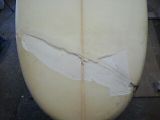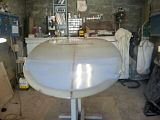Hey All,
…been awhile. This lady named Sandy slowed us down a bit here on the East Coast. Fortunately, all of my tools and materials found their way to the top of my workbench in plastic bags before the storm and I was lucky enough to keep everything.
My shop did take on a good 2 feet of water however. Once the water line dropped and the power came back on I decided to attack the humidity with my dehumidifier. While this was going on, a neighbor brought me a vintage G&S log for some repair. He’d been “drying it out” for a couple weeks.
Now this G&S isn’t a relic but definitely a nice board. I immediately noticed that the nose was buckled with a delammed deck…stress cracks abounding and the first foot of the nose hanging on by sheer will alone. I also noticed the previous repairs a foot behind the current damage. I picked the board up and suspicions were confirmed. My client had repeatedly pearled the board as had the prior owner. The nose was inordinantly heavy for being broken.
Enter wacky idea. With the board’s owner still standing there, I grabbed the Dremel and cut open the hull across the entire buckled nose. Then I bent the nose back and water literally streamed from the crack. I told the owner to come back in 2 weeks and all would be well. He walked away, a nervous look on his face; me smiling. I looked at my dehumidifier then looked at the board and then at my shopvac. I cleaned up all of the edges, opened up and exposed foam in the dings through the tail and cut out a larger area of damaged glass around the nose. Then I taped 6mil. plastic around the nose and to the shopvac hose. Again, I taped more plastic around the intake of the dehumidifier along with the other end of the shopvac hose. A flick of the switch and I walked away.
Two days later, I returned to my shop. Lo and behold, more than 10 cups of water had been sucked from the board!! I dismantled my homemade foam straw and checked the buckled area. My inner skeptic told me that the vacuum bag style water removal couldn’t have been from the board but instead the humidity of the shop itself. Shut up inner skeptic! I lifted the board and, somehow, the board’s weight had changed. I again bent the buckled nose and the foam didn’t have so much as a droplet of water. Dry to the touch.
I then proceeded to rebuild the nose, glass the repair and hotcoat it with no issues.
The owner was stoked. I just recently caught up with him after he had the board back in the water. I asked, “so, did you pearl anymore?” He responded that he hadn’t. “How’d she ride?” I asked. He told me it was as if he had a brand new board; that he had to re-learn how to ride a board that was not nose heavy. She was faster, more responsive to his directional commands. He was spending more time surfing and less time in the whitewater.
And so begins the story of adapting to a ding repair nightmare of soaking wet foam. Any other stories out there about using dehumidifiers for this?
I’ve been trying to think of any dangers in following this method for board repair. The only thing I can think of is this: if a board is waterlogged and ALREADY has delaminations (mostly deck), drying the board out with this method might further separate the existing glass from any water-damaged foam thus revealing further delam issues. Any thoughts or comments are welcome.


